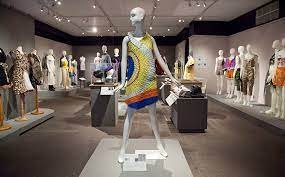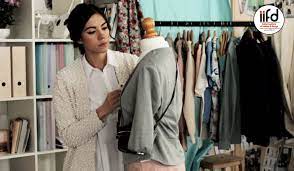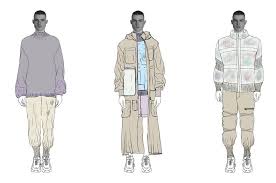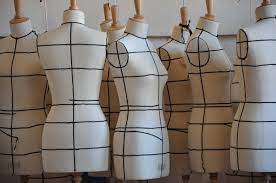What is Sustainable Fashion Degree? What is The Difference Between Eco Fashion and Sustainable Fashion? Which is Best for Career
Sustainable Fashion:
Sustainable fashion is an approach to designing, producing, and distributing clothing, footwear, and accessories that prioritize environmental and social responsibility. It aims to reduce the negative impact of the fashion industry on the environment and society, while also meeting the needs of consumers and preserving the cultural significance of fashion.
A sustainable fashion degree is a program of study that focuses on the principles and practices of sustainable fashion. It typically covers a wide range of topics, including the environmental impact of fashion production, sustainable design, ethical and social responsibility in fashion, and consumer behavior and marketing.

The goal of a sustainable fashion degree is to prepare students to become leaders and change-makers in the fashion industry, equipped with the knowledge and skills necessary to create positive environmental and social impact. Graduates of sustainable fashion programs may go on to work in a variety of fields, including sustainable design, production, marketing, and policy-making.
One of the primary focuses of a sustainable fashion degree is the environmental impact of the fashion industry. The fashion industry is notorious for its resource-intensive production processes, from the cultivation of raw materials to the manufacturing of garments. Sustainable fashion programs teach students about the negative environmental impacts of these processes, including water pollution, land degradation, and greenhouse gas emissions, and explore ways to reduce or mitigate these impacts through sustainable production practices.
Sustainable fashion programs also emphasize the importance of sustainable design. This involves designing products that are made to last, with materials that are renewable, recycled, or biodegradable. Sustainable design also involves minimizing waste throughout the production process and designing for disassembly, so that products can be easily recycled or repurposed at the end of their lifecycle.

In addition to environmental sustainability, sustainable fashion programs also address the ethical and social responsibility of the fashion industry. This includes issues such as fair labor practices, animal welfare, and cultural appropriation. Students learn about the social and ethical implications of fashion production and consumption, and explore ways to create positive social impact through their work in the industry.
Sustainable fashion programs also teach students about consumer behavior and marketing. This includes understanding the motivations behind consumer choices, as well as the role of marketing in shaping those choices. Sustainable fashion graduates are equipped to develop marketing strategies that prioritize sustainability and ethics, and to engage consumers in the movement towards a more sustainable fashion industry.
Finally, sustainable fashion programs often include hands-on experiences, such as internships or design projects, that allow students to apply their knowledge and skills in real-world settings. This provides students with valuable experience and connections in the industry, and helps to prepare them for careers as sustainable fashion professionals.

Overall, a sustainable fashion degree provides students with the knowledge and skills necessary to create positive environmental and social impact in the fashion industry. It equips graduates to become leaders and change-makers in an industry that is in dire need of sustainable solutions, and prepares them to create a more sustainable, ethical, and culturally significant fashion future.
What is The Difference Between Eco Fashion and Sustainable Fashion?
Eco fashion and sustainable fashion are two terms that are often used interchangeably in the fashion industry, but they have distinct meanings and approaches. While both aim to reduce the negative environmental impact of the fashion industry, they do so in different ways.
Eco fashion, also known as environmentally friendly fashion, focuses primarily on reducing the environmental impact of fashion through the use of eco-friendly materials and production methods. Eco fashion often uses organic or natural fibers, such as cotton, hemp, or bamboo, which are grown without the use of harmful chemicals or pesticides. It also includes the use of recycled or upcycled materials, such as reclaimed fabrics or repurposed garments.
In addition to eco-friendly materials, eco fashion also prioritizes environmentally friendly production methods. This includes using renewable energy sources, such as solar or wind power, in production facilities, and reducing water and energy consumption during the manufacturing process.

While eco fashion is focused on reducing the environmental impact of fashion, it does not necessarily address the social or ethical implications of fashion production. This is where sustainable fashion comes in.
Sustainable fashion, on the other hand, takes a more holistic approach to reducing the negative impact of the fashion industry. In addition to environmental sustainability, sustainable fashion also prioritizes social and ethical responsibility in fashion production.
Sustainable fashion encompasses a broader range of considerations, including fair labor practices, animal welfare, and cultural sensitivity. This means that sustainable fashion products are produced in a way that ensures fair wages and safe working conditions for workers, respects the rights and welfare of animals, and avoids cultural appropriation or exploitation.
Sustainable fashion also includes a focus on product longevity and circularity. This means designing and producing garments that are made to last, and can be reused, recycled, or repurposed at the end of their lifecycle. It also includes incorporating closed-loop systems into production processes, which allow materials to be recycled or repurposed back into the same product or a different product.
While eco fashion and sustainable fashion have different approaches and priorities, they are not mutually exclusive. Many sustainable fashion products incorporate eco-friendly materials and production methods, while many eco fashion brands also prioritize social and ethical responsibility.

Ultimately, the goal of both eco fashion and sustainable fashion is to create a fashion industry that is environmentally responsible, socially and ethically conscious, and economically viable. By supporting brands and products that prioritize these values, consumers can help to create a more sustainable and responsible fashion industry.
Sustainable Fashion:
Sustainable fashion is an approach to designing, producing, and distributing clothing, footwear, and accessories that prioritize environmental and social responsibility. It aims to reduce the negative impact of the fashion industry on the environment and society, while also meeting the needs of consumers and preserving the cultural significance of fashion.
A sustainable fashion degree is a program of study that focuses on the principles and practices of sustainable fashion. It typically covers a wide range of topics, including the environmental impact of fashion production, sustainable design, ethical and social responsibility in fashion, and consumer behavior and marketing.

The goal of a sustainable fashion degree is to prepare students to become leaders and change-makers in the fashion industry, equipped with the knowledge and skills necessary to create positive environmental and social impact. Graduates of sustainable fashion programs may go on to work in a variety of fields, including sustainable design, production, marketing, and policy-making.
One of the primary focuses of a sustainable fashion degree is the environmental impact of the fashion industry. The fashion industry is notorious for its resource-intensive production processes, from the cultivation of raw materials to the manufacturing of garments. Sustainable fashion programs teach students about the negative environmental impacts of these processes, including water pollution, land degradation, and greenhouse gas emissions, and explore ways to reduce or mitigate these impacts through sustainable production practices.
Sustainable fashion programs also emphasize the importance of sustainable design. This involves designing products that are made to last, with materials that are renewable, recycled, or biodegradable. Sustainable design also involves minimizing waste throughout the production process and designing for disassembly, so that products can be easily recycled or repurposed at the end of their lifecycle.

In addition to environmental sustainability, sustainable fashion programs also address the ethical and social responsibility of the fashion industry. This includes issues such as fair labor practices, animal welfare, and cultural appropriation. Students learn about the social and ethical implications of fashion production and consumption, and explore ways to create positive social impact through their work in the industry.
Sustainable fashion programs also teach students about consumer behavior and marketing. This includes understanding the motivations behind consumer choices, as well as the role of marketing in shaping those choices. Sustainable fashion graduates are equipped to develop marketing strategies that prioritize sustainability and ethics, and to engage consumers in the movement towards a more sustainable fashion industry.
Finally, sustainable fashion programs often include hands-on experiences, such as internships or design projects, that allow students to apply their knowledge and skills in real-world settings. This provides students with valuable experience and connections in the industry, and helps to prepare them for careers as sustainable fashion professionals.

Overall, a sustainable fashion degree provides students with the knowledge and skills necessary to create positive environmental and social impact in the fashion industry. It equips graduates to become leaders and change-makers in an industry that is in dire need of sustainable solutions, and prepares them to create a more sustainable, ethical, and culturally significant fashion future.
What is The Difference Between Eco Fashion and Sustainable Fashion?
Eco fashion and sustainable fashion are two terms that are often used interchangeably in the fashion industry, but they have distinct meanings and approaches. While both aim to reduce the negative environmental impact of the fashion industry, they do so in different ways.
Eco fashion, also known as environmentally friendly fashion, focuses primarily on reducing the environmental impact of fashion through the use of eco-friendly materials and production methods. Eco fashion often uses organic or natural fibers, such as cotton, hemp, or bamboo, which are grown without the use of harmful chemicals or pesticides. It also includes the use of recycled or upcycled materials, such as reclaimed fabrics or repurposed garments.
In addition to eco-friendly materials, eco fashion also prioritizes environmentally friendly production methods. This includes using renewable energy sources, such as solar or wind power, in production facilities, and reducing water and energy consumption during the manufacturing process.

While eco fashion is focused on reducing the environmental impact of fashion, it does not necessarily address the social or ethical implications of fashion production. This is where sustainable fashion comes in.
Sustainable fashion, on the other hand, takes a more holistic approach to reducing the negative impact of the fashion industry. In addition to environmental sustainability, sustainable fashion also prioritizes social and ethical responsibility in fashion production.
Sustainable fashion encompasses a broader range of considerations, including fair labor practices, animal welfare, and cultural sensitivity. This means that sustainable fashion products are produced in a way that ensures fair wages and safe working conditions for workers, respects the rights and welfare of animals, and avoids cultural appropriation or exploitation.
Sustainable fashion also includes a focus on product longevity and circularity. This means designing and producing garments that are made to last, and can be reused, recycled, or repurposed at the end of their lifecycle. It also includes incorporating closed-loop systems into production processes, which allow materials to be recycled or repurposed back into the same product or a different product.
While eco fashion and sustainable fashion have different approaches and priorities, they are not mutually exclusive. Many sustainable fashion products incorporate eco-friendly materials and production methods, while many eco fashion brands also prioritize social and ethical responsibility.

Ultimately, the goal of both eco fashion and sustainable fashion is to create a fashion industry that is environmentally responsible, socially and ethically conscious, and economically viable. By supporting brands and products that prioritize these values, consumers can help to create a more sustainable and responsible fashion industry.
Sustainable Fashion:
Sustainable fashion is an approach to designing, producing, and distributing clothing, footwear, and accessories that prioritize environmental and social responsibility. It aims to reduce the negative impact of the fashion industry on the environment and society, while also meeting the needs of consumers and preserving the cultural significance of fashion.
A sustainable fashion degree is a program of study that focuses on the principles and practices of sustainable fashion. It typically covers a wide range of topics, including the environmental impact of fashion production, sustainable design, ethical and social responsibility in fashion, and consumer behavior and marketing.

The goal of a sustainable fashion degree is to prepare students to become leaders and change-makers in the fashion industry, equipped with the knowledge and skills necessary to create positive environmental and social impact. Graduates of sustainable fashion programs may go on to work in a variety of fields, including sustainable design, production, marketing, and policy-making.
One of the primary focuses of a sustainable fashion degree is the environmental impact of the fashion industry. The fashion industry is notorious for its resource-intensive production processes, from the cultivation of raw materials to the manufacturing of garments. Sustainable fashion programs teach students about the negative environmental impacts of these processes, including water pollution, land degradation, and greenhouse gas emissions, and explore ways to reduce or mitigate these impacts through sustainable production practices.
Sustainable fashion programs also emphasize the importance of sustainable design. This involves designing products that are made to last, with materials that are renewable, recycled, or biodegradable. Sustainable design also involves minimizing waste throughout the production process and designing for disassembly, so that products can be easily recycled or repurposed at the end of their lifecycle.

In addition to environmental sustainability, sustainable fashion programs also address the ethical and social responsibility of the fashion industry. This includes issues such as fair labor practices, animal welfare, and cultural appropriation. Students learn about the social and ethical implications of fashion production and consumption, and explore ways to create positive social impact through their work in the industry.
Sustainable fashion programs also teach students about consumer behavior and marketing. This includes understanding the motivations behind consumer choices, as well as the role of marketing in shaping those choices. Sustainable fashion graduates are equipped to develop marketing strategies that prioritize sustainability and ethics, and to engage consumers in the movement towards a more sustainable fashion industry.
Finally, sustainable fashion programs often include hands-on experiences, such as internships or design projects, that allow students to apply their knowledge and skills in real-world settings. This provides students with valuable experience and connections in the industry, and helps to prepare them for careers as sustainable fashion professionals.

Overall, a sustainable fashion degree provides students with the knowledge and skills necessary to create positive environmental and social impact in the fashion industry. It equips graduates to become leaders and change-makers in an industry that is in dire need of sustainable solutions, and prepares them to create a more sustainable, ethical, and culturally significant fashion future.
What is The Difference Between Eco Fashion and Sustainable Fashion?
Eco fashion and sustainable fashion are two terms that are often used interchangeably in the fashion industry, but they have distinct meanings and approaches. While both aim to reduce the negative environmental impact of the fashion industry, they do so in different ways.
Eco fashion, also known as environmentally friendly fashion, focuses primarily on reducing the environmental impact of fashion through the use of eco-friendly materials and production methods. Eco fashion often uses organic or natural fibers, such as cotton, hemp, or bamboo, which are grown without the use of harmful chemicals or pesticides. It also includes the use of recycled or upcycled materials, such as reclaimed fabrics or repurposed garments.
In addition to eco-friendly materials, eco fashion also prioritizes environmentally friendly production methods. This includes using renewable energy sources, such as solar or wind power, in production facilities, and reducing water and energy consumption during the manufacturing process.

While eco fashion is focused on reducing the environmental impact of fashion, it does not necessarily address the social or ethical implications of fashion production. This is where sustainable fashion comes in.
Sustainable fashion, on the other hand, takes a more holistic approach to reducing the negative impact of the fashion industry. In addition to environmental sustainability, sustainable fashion also prioritizes social and ethical responsibility in fashion production.
Sustainable fashion encompasses a broader range of considerations, including fair labor practices, animal welfare, and cultural sensitivity. This means that sustainable fashion products are produced in a way that ensures fair wages and safe working conditions for workers, respects the rights and welfare of animals, and avoids cultural appropriation or exploitation.
Sustainable fashion also includes a focus on product longevity and circularity. This means designing and producing garments that are made to last, and can be reused, recycled, or repurposed at the end of their lifecycle. It also includes incorporating closed-loop systems into production processes, which allow materials to be recycled or repurposed back into the same product or a different product.
While eco fashion and sustainable fashion have different approaches and priorities, they are not mutually exclusive. Many sustainable fashion products incorporate eco-friendly materials and production methods, while many eco fashion brands also prioritize social and ethical responsibility.

Ultimately, the goal of both eco fashion and sustainable fashion is to create a fashion industry that is environmentally responsible, socially and ethically conscious, and economically viable. By supporting brands and products that prioritize these values, consumers can help to create a more sustainable and responsible fashion industry.








